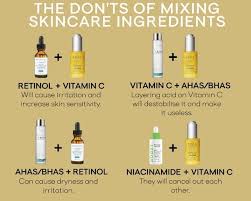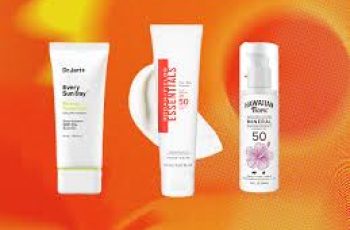
How to Layer Skin Care Ingredients
The best way to layer skin care ingredients and products in your skin care routine depends upon which ingredients the products contain.
This blog discusses product layering and how skin care ingredients interact with each other.
I will discuss what should be considered when designing a skin care routine and how to correctly layer different types of skin care products.
Keep reading to learn more about how individual ingredient characteristics determine how you should combine cosmeceutical ingredients together. You will also learn which products come first in your routine.
Or- take the smartest route!
Take our skin care routine quiz and we will customize a skin care routine for your Baumann Skin Type. You will be able to shop from many brands for each regimen step with the confidence that the products are both right for you and in the correct skin care routine order.
[ctaquiz”>
2 ingredients combine to form a third ingredient
Ingredients have the opportunity to interact with each other when they are:
formulated in skin care products
in contact with each other or mixed together in your hand before applying
layered on your skin above or below other products
applied later in the day or night on top of other products
how to layer skin care products on the skin
Does layering skin care products work?
Two products layered together will act differently than if they are used alone. When you layer the correct products together, you can increase the effectiveness of both.
But if you layer the wrong products together, you can decrease effectiveness and increase side effects.
Using retinoids before or after a moisturizer is a good example of how layering effects how products work.
How to layer skin care products and ingredients
Many skin care routine instructions tell you to wait 3-10 minutes after each layer before applying the next layer. In some cases this will work, but it is best if you use a skin care routine designed so that each layer compliments the next. This way when the ingredients from the various layers combine- you get an even better result.
This is why it is so important to have a skin care routine customized for your Baumann Skin type.
Once you take the quiz and find your skin type- we will help you build a skin care routine that insures that the products are layered properly.
Take the Quiz
skin care products combine like paint does to form a new product
How to layer serums and acids?
Acids can change how well products work by lowering the pH- so the best way to layer serums and acids really depends on which types of ingredients and products you are layering.
The best way to combine a serum and an acid is to use a low pH acid cleanser like a hydroxy acid. This way the acid is washed off the skin before the serum is applied- leaving the skin a lower pH for 3-5 minutes.
Why acid cleansers should be used before serums:
If used before a Vitamin C serum, the low pH will help the ascorbic acid penetrate.
Increases exfoliation which helps serums absorb
Loosens attachments between skin cells helping serums penetrate into the skin
Why you should not layer acidic moisturizers with serums
Most moisturizers have a high pH due to fatty acids, but hydroxy acid moisturizers have a low acidic pH.
Some ingredients get inactivated by an acidic pH such as peptides, and growth factors. These can be applied after acidic cleansers are rinsed off, but should not be layered with acidic moisturizers such as hydroxy acid creams. Glycolic acid, lactic acid, salicylic acid can all decrease effectiveness of some antiaging ingredients if layered together.
An acid pH might break open exosomes before they can penetrate to the dermis, which would decrease efficacy of exosome serums.
There are many intricacies with designing a custom skin care routine for your skin type, so make sure you know which of the 16 skin types you are and design your routine accordingly.
Take the Quiz
How to layer retinol with other ingredients
This is such a complex topic that it has it’s own blog called How to use retinol, hyaluronic acid, niacinamide and vitamin C together.
You can also look at the sections below for which ingredients to use together with retinol and what not to use with retinol.
Retinol Before or After Serum
When to use retinol, Retin A and other retinoids in your skin care routine depends upon many factors. See this blog for more information.
Peptides and Retinol Together
Peptides tend to inactivate other ingredients or clump up with other peptides. For this reason, it is best not to use retinol with a large amount of peptides. If the peptide are low down on the ingredient list on the product label in a product separate from retinol, it should be ok, but do not use a product with retinol and peptides unless I have recommended a specific one for you in your custom skin care routine.
Retinol and Vitamin C Together
It is very hard to stabilize and formulate Vitamin C and retinoids together so these should not be combined in the same product. But you can use them in the same skin care routine. Vitamin
C should come first, followed by retinol- at night only.
Learn more at How to use retinol, hyaluronic acid, niacinamide and vitamin C together.
Retinol and Glycolic Acid (AHA) Together
It is not easy to formulate retinol and AHA together. The brand Skinbetter has done this but in my opinion it is best to use a glycolic acid or AHA cleanser in the am or pm and a separate retinoid at night. There are many reasons for this including better retinol stability and a mor flexible regimen if over-exfoliation occurs. You have the ability to stop one or the other if thy are in separate product. You could also alternate- an AHA one day and a retinoid another day.
How to layer serums and moisturizers?
In general serums come first in routines and moisturizers are layered on top.
The only exception to this is if the serums are actually face oils rather than water-based serums.
How to layer face oils and moisturizers?
There are many different types of face oils and moisturizers.
(Note that some oils are actually essential oils and not true moisturizers.)
When face oils should be used in the regimen depends upon many factors including which Baumann Skin Type you are and what moisturizer and oils you want to use together.
In general- apply the face cream first and use the oil after. This way the oil provides occlusion and slugs the moisturizer into the skin.
How to layer SkinMedica products?
The best step order of SkinMedica products in your skin care routine depends upon your Baumann Skin Type.
General advice on how to layer SkinMedica skin care products:
Always use the TNS recovery complex or growth factor serum first. The growth factors are unstable and need to have the highest change of absorption.
SkinMedica Lytera should be used either as the 2nd or 3rd step in your skin care routine depending on which Baumann Skin Type you are.
The HA5 serum comes after the growth factor, vitamin C. or skin lightening serum. Hyaluronic acid serums will increase absorption of other products. This can increase side effects from retinol, so not all skin types should use the SkinMedica HA5 serum.
Apply SkinMedica Dermal Repair cream after TNS Recovery complex, Essential Serum or HA5
When to use SkinMedica Retinol in your skin care routine depends on variables discussed in this blog.
If you choose to use the Skinmedica retinol, apply it after the TNS Essential serum.
Make sure SkinMedica products are right for your skin type before you buy.
Take the quiz to build a skin care routine in the correct step order with products right for your skin type.
Take the Quiz
How to layer SkinCeuticals products?
The order that you use Skinceuticals products will greatly affect how well they work.
Always use SkinCeuticals products in this order:
Cleanser
Vitamin C serum such as SkinCeuticals C E Ferulic, Pfloretin or AOX10 serum
HA serum
Triple Lipid Repair Moisturizer
Retinoid
When to use the retinoid will vary from skin type to skin type so read this blog about when to use SkinCeuticals retinol. It can be more irritating than other retinols, so make sure you use it as prescribed.
These products and this step order of SkinCeuticals products is not right for all 16 skin types, so take the quiz and we will give you the exact skin care routine steps to match your Baumann Skin Type.
Make sure SkinCeuticals products are right for your skin type before you buy.
Find a dermatologist near you or take the quiz.
Take the Quiz
How to layer La Roche-Posay products in your skin care regimen?
La Roche-Posay has products to treat many different skin concerns. The order you should use the LRP products depends upon your Baumann Skin Type and which products you are using. Your best bet is to take the skin care routine quiz and we will show you what skin care routine steps for you to use.
The advice below is general advice from dermatologists on what order to use La Roche-Posay Products.
Five tips on how to layer La Roche-Posay Products:
Use the La Roche-Posay 10% Pure Vitamin C Serum in step 2 after cleansing
Use the Effaclar Adapalene gel 0.1% Topical Retinoid after your moisturizer when beginning the retinoid.
When to use (and if to use) Hydraphase HA Hyaluronic Acid Moisturizer or Face Cream depends on your skin type. It will increase absorption of other products.
Apply susncreen last in the am
Always apply retinol or adapalene at night.
To get more specific advice- we need to know your skin type.
Take the Quiz
What Order Do I Put on Drunk Elephant Products?
Of course it depends on which of the 16 skin types you are.
Dermatologist do not recommend Drunk Elephant because medical grade skin care brands give better results. But- I get asked this a lot so I included it here.
If you choose to use Drunk Elephant- this s the best way to layer the products for most skin types.
In general this is the best way to layer Drunk Elephant Products in the morning:
ERase Milke Micellar Water
Shaba Complex Eye Serum
C Firma Fresh day Serum
Protini Polypeptide Cream
SPF
How to layer Drunk Elephant Products at night:
Beste No.9 Jelly Cleanser
CeraMightly AF Eye Balm to protect eye area
Vitamin C Serum or Glycolic acid serum
Lala Retro Whipped Cream Fouettee Moisturizer
Drunk Elephant A Passioni Retinol Cream
Virgin Marula Luxury Facial Oil
No matter what skin care brand you choose- laying the products in the correct order is critical to get good results.
I prefer combining the best products from various brands for my patients. To see what I would recommend for you, build a custom skin care routine using the same software that dermatologists use.


